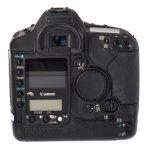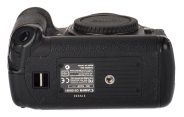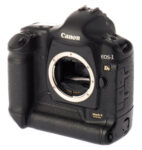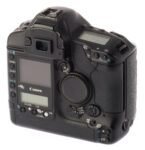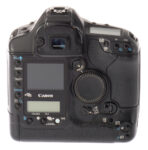Canon EOS 1Ds mark II
35mm AF digital SLR camera • Discontinued
- Announced:
- · September 2004
- Production status:
- ● Discontinued
- Country of design:
- · Japan
- System:
- · Canon EOS (1987)
Specification
| Format: | |
| 35mm full frame | |
Imaging sensor: | 36 × 24mm CMOS sensor |
Resolution: | 4992 × 3328 - 17 MP |
Sensor-shift image stabilization: | - |
| Canon EF [44mm] | |
| Shutter: | |
Type: | Focal-plane |
Model: | Electronically controlled |
Speeds: | 30 - 1/8000 + B |
| Exposure: | |
Exposure metering: | Through-the-lens (TTL), open-aperture |
Exposure modes: | Programmed Auto |
| Aperture-priority Auto | |
| Shutter-priority Auto | |
| Manual | |
| Physical characteristics: | |
Weight: | 1215g |
Dimensions: | 156x157.6x79.9mm |
Manufacturer description #1
The Canon EOS-1Ds Mark II, replacing the 11.1-megapixel EOS-1Ds, is a professional digital AF SLR camera developed primarily to meet the needs of portrait and studio photographers, who demand the highest image quality. Featuring a newly developed full-frame 35 mm CMOS sensor (36 x 24 mm) boasting 16.7 million effective pixels, the world’s highest pixel count among digital SLR cameras*, the EOS-1Ds Mark II realizes superlative image resolution, rich color gradation and a wide ISO sensitivity range (ISO 100-1,600, L:50, H: 3,200). The 35 mm sensor size also allows users to fully utilize the angles of view offered by the entire range of Canon EF lenses**, permitting unrestricted lens performance for a shooting feel on par with film SLR cameras.
The EOS-1Ds Mark II incorporates Canon’s proprietary DIGIC II image engine to maximize the performance potential of the CMOS image sensor. Performing detailed processing of large-volume data at extremely high speeds, the DIGIC II image engine realizes the ultra-fine detail and natural color reproduction demanded by professional users. Also enabling outstanding responsiveness, DIGIC II makes possible continuous shooting of high-quality (JPEG large) images at up to four frames per second for up to 32 consecutive shots, the high-speed writing of image files to the card media, and a fast startup time of just 0.3 seconds.
Canon’s EOS-1Ds Mark II professional digital SLR camera offers a range of new features, including a greater choice of image-quality settings, with four JPEG sizes and ten compression levels in addition to a RAW file setting. Additionally, two customizable color-matrix settings, in addition to five preset modes, enable image optimization according to the requirements of the subject or output device. Moreover, dedicated card slots for CompactFlash and SD memory cards enable simultaneous backup or selective recording to either card, while a video output terminal enables users to view images on a television screen. The model also incorporates a two-inch 230,000 dots LCD monitor which, nearly doubling the resolution of that offered by the previous model, enables magnification up to 10x to effectively check image focus during playback.
The EOS-1Ds Mark II offers outstanding resilience, boasting improvements such as dramatically increased shutter durability capable of withstanding 200,000 cycles. A lightweight, heavy-duty magnesium alloy exterior provides exceeding rigidity as well as electromagnetic shielding, while thorough water- and dust-resistant sealing in 70 locations, including all switches, body seams and memory-card slots, ensures users of unfailing reliability under even the most grueling conditions.
Other advanced features include a maximum shutter speed of 1/8000 second; Canon’s proprietary 45-point area autofocus, which makes photo composition quick and easy by eliminating the need to position the subject at the center of the picture; a 21-Zone Evaluative metering sensor to ensure ideal exposure performance; an advanced full-frame viewfinder; and Custom Function control, which allows users to tailor camera operations to their individual preferences. Moreover, the new EOS-1Ds Mark II features Canon’s E-TTL II flash metering system which, when used with the company’s EX-series Speedlite flashes, utilizes distance information provided through the lens for more precise and stable direct-flash exposure than ever before.
Manufacturer description #2
Amstelveen, the Netherlands, 21 September 2004. Canon, a world leader in photographic and imaging technology, today announces its new flagship camera: the 35mm full-frame 16.7 Megapixel EOS-1Ds Mark II Digital SLR. The camera is expected to appeal to professional studio and commercial photographers.
Featuring a full-frame 36 x 24mm 16.7 Megapixel CMOS sensor, the EOS-1Ds Mark II produces images with outstanding colour rendition and dynamic range. It has sufficient resolution to produce files which convert to 50MB uncompressed TIFF at 24 bit colour depth, now considered standard acceptable size by leading international photo agencies and stock libraries.
Replacing the award winning 11.1 Megapixel EOS-1Ds, the camera is powered by Canon’s second generation DIGIC II image processor and is capable of firing at 4 fps for bursts of up to 32 frames in JPEG, or 11 frames in RAW. An optional wireless adaptor (also released today) delivers high speed IEEE802.11b/g wireless LAN and 100 Megabit per second wired LAN support.
Besides the inherent advantages of digital, such as immediate turn-around and elimination of film costs, it is the flexibility of the EOS 35mm SLR format which Canon expects to appeal to many studio photographers. For the first time, medium format image quality combines with access to the world’s most extensive range of professional lenses, spanning from 14mm to 1200mm.
“The EOS-1Ds Mark II is a tremendous achievement, it represents the pinnacle of Canon’s digital camera technology,” said Mogens Jensen, Head of Canon Consumer Imaging Europe. “With its resolution, image quality, immediacy of wireless and the power and flexibility of SLR, the EOS-1Ds Mark II offers the first real digital alternative to medium format, which has so far been the choice for mainstream commercial studio and location work.”
Canon expects the camera to be adopted in areas such as fashion, car, calendar, advertising and architectural photography.
Key camera specifications include:
- 16.7 MP full frame 36 x 24mm CMOS sensor
- 0.3 second start up and 4fps performance
- ISO 100-1600, expandable to L:50 and H:3200
- Digital Photo Professional v1.5 RAW processing s/ware with support for sRGB, Adobe RGB and wide gamut RGB colour spaces plus various European, North American and Japanese standard CMYK separation simulations
- Hi-Speed FireWire, & Video out i/face for complete connectivity
- Dual high performance SD and CF/CF-II card slots (supports cards greater than 2GB)
- Complete compatibility to all EF lenses & EX-series Speedlites
- 2.0” LCD screen with 230,000 pixels, 1.5-10x playback zoom
- Simultaneous RAW & JPEG shooting
- Battery life – approximately 1200 shots @ 20C, 800 at 0C – in accordance with CIPA testing standards
Unsurpassed image quality
The full frame 16.7 Megapixel resolution sensor has a built in low-pass filter to reduce false colour and moiré effects, which can appear when shooting subjects with fine regular detail, such as textiles. The second generation DIGIC II processor delivers 0.3 sec start up time, fast continuous shooting and simultaneous RAW and JPEG recording. It also features advances in the image processing algorithms to improve white balance, auto exposure and overall image quality. Photographers can choose between four resolutions and 10 quality levels for JPEG images. Within the camera, the EOS-1Ds Mark II supports sRGB and Adobe RGB colour spaces with user settable colour saturation and tone levels, and provides five preset and two user-definable colour matrices. When using the Digital Photo Professional software and RAW image files, Wide Gamut RGB is also available. White Balance (WB) bias is correctable by +/- 9 levels for both blue/amber and magenta/green bias and the camera supports WB bracketing up to +/- 3 levels.
Flexibility of SLR in the studio
Photographers switching to Canon’s EOS system open up access to over 60 EF lenses, including tilt-shift, macro, super telephoto and Image Stabilizer lenses. The EOS-1Ds Mark II is compatible with the entire range of EX-Series Speedlite flash units, including two macro set ups and a range of wireless master/slave flash solutions. For photographers comfortable with the vertical orientation viewfinders of some medium format cameras, the camera accepts an optional Angle finder C right-angle viewfinder.
The immediacy of wireless image transfer
With the optional Wireless LAN adapter plugged into the camera’s IEEE1394/Firewire connection, photographers can work untethered as huge full-frame RAW files transfer automatically to the studio LAN in seconds . “A London publisher can now lay out a production-ready front cover of a magazine with a photograph taken literally seconds beforehand in a Milan studio,” observes Jensen. “Once this level of immediacy becomes commonplace, it is hard to imagine anyone accepting the risks and costs associated with the delays of film developing.”
The Wireless LAN adapter supports both IEEE802.11b, IEEE802.11g wireless network standards and also includes a 100 Megabit wired ethernet connector for automatic and immediate transfer to any wide or local area network. The system supports a comprehensive range of major wireless network encryption and security features.
The CMOS advantage
The EOS-1Ds Mark II’s CMOS sensor offers lower noise levels and a superior dynamic range (capacity to capture subtle tonal gradations in shadow, midtone and highlight areas) to that of sensors found in other digital cameras and camera backs. Canon is the only camera manufacturer with a history of significant research and development investment into image sensors. The resulting CMOS sensor technology found in its digital SLR range is key to the company’s competitive advantage. CMOS sensors have formed the basis of a long line of award winning cameras including the EOS-1Ds, EOS-1D and EOS 10D. Such is the strength of Canon’s sensor development that this is the third new CMOS sensor Canon has commercialised this year. Canon’s first commercialised sensor technology formed the basis of the 1987 EOS auto focus system, with CMOS technology first appearing as an image sensor in the 2000 EOS D30.
RAW processing
Digital Photo Professional v.1.5 image processing software is provided for high-speed processing of lossless RAW files. Processing with Digital Photo Professional is approx. 6 times faster than the File Viewer Utility supplied with the EOS-1Ds. It allows real-time display and immediate application of adjustments to images and includes a wide array of RAW, TIFF or JPEG image editing functions, which give control over variables such as white balance, dynamic range, exposure compensation and colour tone. sRGB, Adobe RGB and Wide Gamut RGB colour spaces are supported, and an ICC (International Colour Consortium) profile is automatically attached to RAW images that have been converted to TIFF of JPEG formats. This allows images to be displayed in their faithful colours in software applications that support ICC profiles, such as Adobe Photoshop. Image processing of various parameter changes can now be batched rather than carried out sequentially, vastly increasing the efficiency of applying a number of changes to the same images. The new version of Digital Photo Professional adds the ability to simulate the CMYK separation of images based on regular Japanese, European and USA printing industry practices.
Similar cameras (1)
| Model | Shutter | Metering | Modes | Year |
|---|---|---|---|---|
| Kodak DCS Pro SLR/c | E, 1/6000 | TTL · OA | PASM | 2004 ● |


